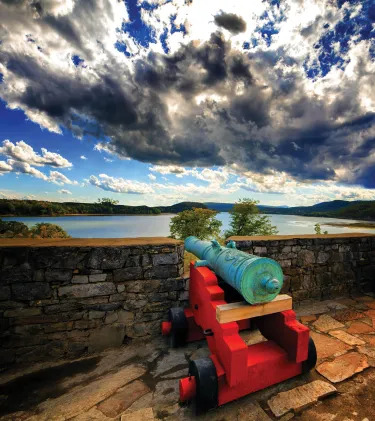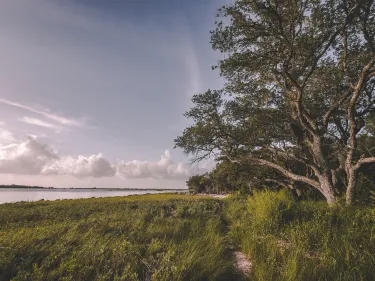American Battlefield Trust Targets Land at Three Revolutionary War Sites — Two of Which Boast Connections to Additional Conflicts
Mary Koik, (202) 367-1861 x7231
(Washington, D.C.) — In its latest land preservation campaign, the American Battlefield Trust, the nation’s leading historic land preservation organization, is targeting seven acres spread across three Revolutionary War sites in New York and South Carolina. Due to intersecting layers of history, two of the sites are equally related to other conflicts: the French and Indian War and the Civil War.
Given their prominent locations and layered histories, these landscapes are valued at over $2.7 million, but thanks to a variety of matching grant programs and generous donors, the Trust is left with just $62,000 to raise from individual gifts creating a 45-to-1 return on investment. Fundraising to complete the project is currently underway online at www.battlefields.org/45to1match. The initiative will also contribute toward the Trust’s ambitious goal of protecting 2,500 acres of Revolutionary War battlefield land to commemorate the 250th anniversary of that conflict.
“The narrative of America’s past is a complex tapestry,” said Trust President David Duncan. “Places of extreme strategic significance during one conflict do not fade away when the guns fall silent and may play key roles time and again. Ensuring that these places where the past echoes so powerfully are protected forever is especially rewarding.”

Fort Ticonderoga, overlooking Lake Champlain from Upstate New York, was established by the French as Fort Carillon in 1755 and played a key role in the North American theater of the Seven Years War, commonly known in America and the French and Indian War. Although defeated there in 1758, the British captured and renamed the fort 1759, holding it, despite battle damage and disrepair, as a small frontier garrison the 1770s. Just one month into the Revolutionary War, Fort Ticonderoga was captured without bloodshed by a contingent of Green Mountain Boys and New England militia led by Ethan Allen and Benedict Arnold. During the winter of 1775-1776, a daring maneuver brought the fort’s significant artillery to Boston, where its looming threat forced British evacuation of the city on March 17. Still formidable and at a key location, Fort Ticonderoga also played a role in the 1775 invasion of Quebec and the 1777 Saratoga Campaign.
Today, the American Battlefield Trust is working with the Fort Ticonderoga Association, which operates the acclaimed historic site, to protect just under one acre adjacent to its holdings. Review of the historical records indicate the potential presence of archaeological sites related to the 1758 Battle of Carillon that lie outside of Fort Ticonderoga proper, including fortified camps and a temporary hospital site. Once secured and cleared of modern structures, this land will shed new light on this era of history.
The Trust is also moving to protect what remains of the site of Fort Johnson, on James Island just off Charleston, S.C. In September 1775, the Council of Safety ordered the 2nd South Carolina Regiment — including a company commanded by Francis Marion, known to history as the Swamp Fox — to seize Fort Johnson, which it did with little resistance. More than four score years later, at 4:30 a.m., on April 12, 1861, a flaming mortar shot from Fort Johnson arced into the air and exploded over Fort Sumter, beginning the American Civil War. With its stunning water views and the hot Charleston real estate market, this site is a developer’s dream, but priceless in the eyes of historic preservationists.

The largest property is four acres at Eutaw Springs, a key moment in the Southern Campaigns when it became evident that Patriot forces would contest each battle — a fierce determination that ultimately pushed British General Lord Charles Cornwallis out of the Carolinas into Virginia and surrender. Across the street from interpreted parkland, this property, with its buildings deteriorating and largely abandoned, has long been a target for preservation and restoration. The Trust will remove modern structures to restore the area to its period appearance, greatly enhancing the experience of visitors to this budding heritage tourism destination on the organization’s Liberty Trail.
Among the many partner organizations and entities that came together to make this exceptional three-part project possible are: the National Park Service’s American Battlefield Protection Program; the State of South Carolina, especially its Department of Natural Resources and Department of Parks, Recreation and Tourism; the South Carolina Battleground Preservation Trust; the Medical University of South Carolina; and the Fort Ticonderoga Association, Inc.
Private donations to the effort, which will be matched $45-to-$1 due to a combined variety of federal and state grants with previous gifts, may be made online at www.battlefeilds.org/45to1match.
The American Battlefield Trust is dedicated to preserving America’s hallowed battlegrounds and educating the public about what happened there and why it matters today. The nonprofit, nonpartisan organization has protected more than 55,000 acres associated with the Revolutionary War, War of 1812 and Civil War. Learn more at www.battlefields.org.
###